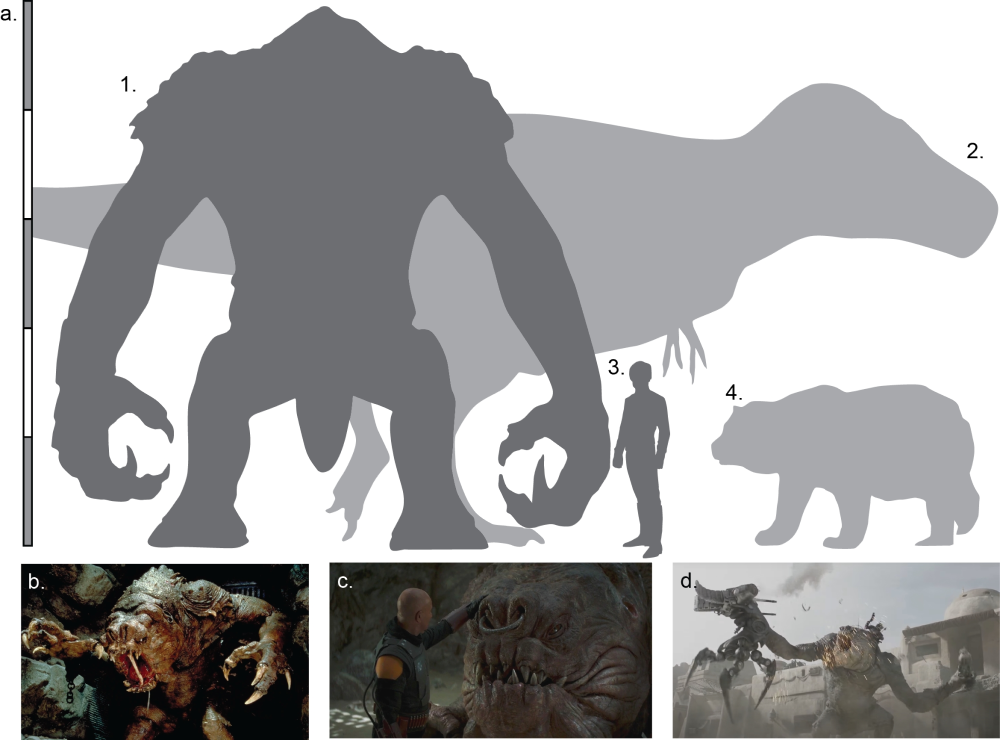A new study has borrowed a few tricks from palaeontological science to estimate whether or not the Rancor from Star Wars could really have chomped a femur in half. It found that, actually, yes – the Rancor’s bite comes in at a bone-crushing force of 44,000 Newtons, which about puts it on par with a Tyrannosaurus rex.
In case you need a refresher, we’re talking about that scene where Luke Skywalker gets trapped in Jabba the Hutt’s deadly arena and finds himself facing down the Rancor. In a bit of a bind, he buys himself some time by jamming a giant leg bone in the open mouth of the enormous beast. The Rancor makes reasonably quick work of the femur, chomping it in half despite femurs being famously good at resisting high levels of vertical loading.
A memorable scene, and one that sparked inspiration for lead author Dr Stephan Lautenschlager, a vertebrate palaeontologist and Associate Professor for Palaeobiology at The University of Birmingham, and co-author Dr Thomas Clements, who is now based at Friedrich-Alexander-Universität Erlangen-Nürnberg.
“During lockdown, Thomas had re-watched the original Star Wars trilogy (for the two hundredth time) and saw the Rancor effortlessly chomping the bone,” Lautenschlager told IFLScience. “He and I were chatting later and he asked me if it was possible for anything to snap a vertical bone with its jaw and if anyone had ever modelled it.”
The fun thing about scientists is that what would normally be confined to Shower Thoughts instead turns into a study published in the Journal of Geek Studies titled: Is a Bone a Viable Weapon When Combating a Rancor? Estimating the Bite Force of an Intergalactic Mega-Predator. In it, Clements and Lautenschlager use computer simulations and biomechanical modeling to analyze the monster encounter, determining that the Rancor had a bite force that tops every predator alive today.

Don’t even ask about the bite force of humans. Embarrassing.
Image courtesy of Dr Stephan Lautenschlager and Dr Thomas Clements
The white shark sits at around 18,000 Newtons, while the saltwater crocodile clocks in at 16,000 Newtons, all puny nibbles compared to the Rancor, whose theoretical bite force is a bone-crushing 44,000 Newtons. Could any animal that’s ever lived have rivaled it? Well, possibly.
One thing to consider is that T. rex wouldn’t be able to lift Luke towards its mouth – maybe Luke might not have gotten away so easily!
Lautenschlager and Clements
“The bite force of a T. rex is comparable if not higher than the Rancor’s,” said Clements and Lautenschlager, meaning that it too wouldn’t be bested by a big bone. “The skull, teeth and musculature of T. rex is adapted for extremely strong bite forces and crushing bone. In fact, its teeth are not thin and blade-like as in other carnivorous dinosaurs but have a round cross-section – ideal to pulverise bone.”
“This is helped by its strong skull and lower jaws that are built to withstand high stresses during feeding. One thing to consider is that T. rex wouldn’t be able to lift Luke towards its mouth – maybe Luke might not have gotten away so easily!”
It is, of course, all a bit of fun, but there are important takeaways to the research, too. It demonstrates how science and creativity are constantly overlapping as researchers try and problem solve their way through obstacles like incomplete fossil records and decomposed soft tissue. Taking inspiration from unlikely sources can often be the tipping point to solving some of life’s greatest mysteries.
As many of the fossils we use are incomplete or damaged during the fossilisation process, we have developed methods that can mitigate these issues – and by taking them one step further we can apply our methods to a fictional animal
Lautenschlager and Clements
“Many of the methods we employ as palaeontologists were not originally designed for palaeontological research but come from engineering and biomedical disciplines – we have co-opted them to answer interesting questions about dinosaurs and other extinct organisms that the bones alone can’t tell us,” say Clements and Lautenschlager.
“As many of the fossils we use are incomplete or damaged during the fossilisation process, we have developed methods that can mitigate these issues – and by taking them one step further we can apply our methods to a fictional animal. While this study is a bit of fun, it shows that our methods and approaches are really versatile. Plus, who else can say they have published a study on extraterrestrial mega-predators?”
I, for one, am jealous.
The study is published in the (wonderfully named) Journal of Geek Studies.
Source Link: Is A Bone A Worthy Weapon When Fighting The Rancor? What About A T. Rex?